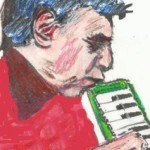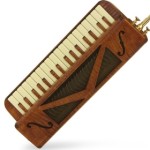Melodica Produces Wide Range of Sounds and Textures
Tagged: Melodica sounds
- This topic has 21 replies, 5 voices, and was last updated 6 years, 3 months ago by
 Alan Brinton.
Alan Brinton.
-
AuthorPosts
-
March 18, 2017 at 2:40 pm #8493
 LowboyParticipant
LowboyParticipantHi,
I completed another one of my studies. While this study uses some of the same techniques I have presented before, the study is special because it was recorded fully acoustically: melodica in room with cathedral ceiling into microphone into pocket recorder. No processing in any way. It also pushes the limits of some of the modulation techniques I use.
I hear the following textures and implied sounds: trumpet, brass section, orchestra, Japanese flute, analog synth, melodica, harmonica, and maybe an animal call or two.
The melodica is an expressive instrument!
The instrument used are a Hohner full size Piano 26, Cassotto 26, and Piano 32.
Lowboy
March 18, 2017 at 6:55 pm #8545 jazzman1945Participant
jazzman1945ParticipantLowboy, hi! Good sound effects! Regarding big intervals , like fifth + octave, which played by two hands: using different pressing depth can be dynamically allocate each sound separately.
March 18, 2017 at 8:01 pm #8554 Alan BrintonParticipant
Alan BrintonParticipantI can’t tell you how much your studies and Quetscher’s sound samples are helping me with my technique. I have been amazed at the extent to which I am able to replicate many of the sound effects and also to play along improvisationally. Some things I’m consciously incorporating into my playing, but it goes way beyond that in its influence on how I play my melodicas. It has changed my “musicality” expectations for what is possible for me as a player. It also gives me a better understanding of the possibilities (and limitations) of different melodicas. Cost: nothing; Benefits: immeasurable.
March 19, 2017 at 9:54 pm #8719 LowboyParticipant
LowboyParticipantThanks for the kind and inspiring words Jazzman and Alan.
I would clarify Jazzman’s comments that while some of these effects are novel or “sound effects,” most are actually playing techniques I use for expression when performing. It is a real challenge to apply these techniques while playing in a live situation. They are best used in a low-stage-volume acoustic setting where the subtleties can be heard.
By the way, several weeks ago, I joined a new band where where I play Hammond organ. I will play melodica on a few songs. But better than that, this group has a subgroup that plays in an acoustic trio setting, where I will be playing melodica exclusively. We will be performing a lot this summer. So I am excited about getting out there again this season with the melodica and further developing my sound and playing style.
The band website is: http://www.thechickenyard.com
Regards,
Lowboy
March 19, 2017 at 9:57 pm #8720 LowboyParticipant
LowboyParticipantHi Alan and Jazzman,
I have more techniques that I recorded but that did not make it on to this study. Hopefully I will be able to assembly another study soon with the additional techniques I recorded.
Regards,
Lowboy
March 20, 2017 at 6:17 pm #8728 DarenKeymaster
DarenKeymasterSome really interesting sounds here, that could be used to add some subtlety and expression in performance. Would you consider making a video? It would be really good to see what you’re doing to make them
March 21, 2017 at 9:51 am #8730 QuetscherParticipant
QuetscherParticipantGreat work once again, Lowboy!
I would also love to see a video of your techniques, sometimes it’s really difficult to understand what you’re doing while you produce certain effects without seeing…
March 24, 2017 at 2:27 pm #8759 LowboyParticipant
LowboyParticipantHi Daren and Quetscher,
I am not much of a video guy, thought the thought of creating a video has entered my mind often. I am sure it will happen some day. I will, however, try to shoot some stills in the next week or three.
There are no secrets here. I have published nearly everything I know about these techniques on Melodica World over the last two years.
1. Buy a Hohner Piano 26 with the “true” sound holes on the back
2. Add a 12- to 14-inch piece of curved tubing and your favorite mouthpiece
3. Take off your shirt.
4. Okay, you don’t have to take off your shirt. But you should wear a thin shirt so you can seal the back of the melodica against your chest when needed. Sometimes, a bulky shirt of the right material also works well.
5. Hold the melodica at the bottom and jam the top up under your chin. The melodica should lay flat against the upper part of your chest. For certain techniques, your chin helps you clamp the melodica tightly against your chest. (I sometimes play the lowest note as a drone with my chin. Sometimes you need to drop the melodica down or release your chin so that you can lift the melodica from your chest.)
6. Play the melodica while you clamp, seal, release, raise, wave, wobble, pound, flail, beat, flog, and tilt it in relationship to your chest, and if recording or being amplified, in relationship to the microphone.
7. If recording, place at microphone chest high on the left side and play the microphone to enhance the effects. You can get doppler effects, volume modulation, proximity effects, etc.
8. Use breathing and mouth techniques as usual
9. Use imagination as I don’t think I have explored all the possibilities here.
If you like that, then start digging in deeper by modifying the melodica (cut the protrusions from the back, remove the handle). Sew a melodica apron. All this is documented on Melodica World.
Regards,
Lowboy
March 26, 2017 at 2:52 pm #8767 LowboyParticipant
LowboyParticipantThe photo below is a Hohner Piano 26 to which I added a bead of silicone to the back to help seal the sound outlet against my chest. With this arrangement–particularly when used with a vinyl melodica apron–you can fully choke the outlet. When pressed against your chest, you get a soft smooth sound. As you allow one side of the melodica to lift from your chest, the sound become louder and brighter. Movement that ranges anywhere between holding the melodica super tight against your chest to waving it freely in space (and in and around the microphone) produces a wide range of tonalities and modulations.
This photo shows an early experiment. I normally cut off the standoffs, water valve outlet hood, and remove the handle before adding the silicone.
When I say hold the melodica at the bottom, I mean at the bottom where the water valve is. Obviously you can’t hold the melodica from the back side and press it against your chest.
Lowboy
 March 26, 2017 at 4:00 pm #8768
March 26, 2017 at 4:00 pm #8768 Alan BrintonParticipant
Alan BrintonParticipantIngenious! How do you suppose weather stripping would work? The kind used around windows and doors, which come in various sizes and shapes. On my heavy sliding patio door, there is heavy hard rubber stripping that’s about 1/2 inch thick. It seems like the higher the ridge, the easier it would be to produce the kinds of effects you’re getting, and the less the body surface (apron or whatever) would matter.
At the Musical Instrument Museum in Phoenix, I saw an instrument (can’t remember whether wind or string) with a half coconut shell that the player cups against his bare belly. I think is was a Polynesian folk instrument. I have not been able to find something like this on the Internet, though use of coconut shells in folk instruments is common.
March 26, 2017 at 4:17 pm #8769 Alan BrintonParticipant
Alan BrintonParticipantI think the instrument was a kind of fiddle with the inverted open coconut half shell pressed against the belly. There are eastern Mediterranian fiddles that look like this, but the soundbox does not appear to be open on the bottom.
March 26, 2017 at 6:32 pm #8770 LowboyParticipant
LowboyParticipantA good and less messy idea Alan. I think the right kind of weather stripping could work fine and be easier and faster to install. Lowboy
March 26, 2017 at 6:48 pm #8771 LowboyParticipant
LowboyParticipantHere is a photo of me holding the melodica in one of the basic playing position and using a melodica apron. In this case, I am using one finger on my left hand to hold down the high G. I really like to accent chords on occasion by punching them while holding down a high note with my left hand.
As noted before, once in a great while I will use my chin to hold down the low F as a drone or accent note. Note that this melodica is a Piano 27, not a Piano 26. Both work fine.
It would seem there is one disadvantage to playing this way. The throat is bent and not as open as it could be. So far, I can hardly tell the difference between this position and a heads up position as it relates to air flow and diaphragm techniques.
Lowboy Bootay
 March 26, 2017 at 9:23 pm #8772
March 26, 2017 at 9:23 pm #8772 Alan BrintonParticipant
Alan BrintonParticipantHere’s a type of weather stripping that looks like it might work, respectively 3M .3″ high, Trim-Lok .36″ high, and Trim-Lok .75″ high. For car doors. Should have strong adhesive.
https://lucy421.smugmug.com/Other-1/Melodica-Maintenance/i-2RKrZ93/A — $11.99 for 196″
https://lucy421.smugmug.com/Other-1/Melodica-Maintenance/i-r6CwZKr/A — $15.61 for 25′
https://lucy421.smugmug.com/Other-1/Melodica-Maintenance/i-8WJ65bX/A — $53.22 for 25′I may give this a try, as I have several of the relevant Piano 26 and Piano 32 models.
Trim-Lok also comes in 1/2″.
March 26, 2017 at 9:42 pm #8773 LowboyParticipant
LowboyParticipantWow Alan. Those look like they could work really well. You may have to cut off the standoffs with a coping saw to get a clean and even fit around the perimeter of the raised part. Or maybe, if the weather stripping is sufficiently tall, you can just wrap it outside of the raised portion.
Let’s see a photo of that when you get done.
Using the medical grade tubing I discovered last week and your improved way to seal the outlet could really help improve sound quality and playability.
Regards,
Lowboy
-
AuthorPosts
- You must be logged in to reply to this topic.
